Hardenbergia is a lovable evergreen native named after Franziska Countess von Hardenberg, a 19th century Austrian botany patron. Part of the plant’s charm is that it will adapt to almost any spot you put it in. With deep green, leathery leaves and pea-shaped clusters of flowers, even the birds and butterflies are romanced by the Hardenbergia.
In our how to grow and care guide, we’ll talk through the needs of the Hardenbergia in terms of light, soil and pruning, how to propagate your own plant from softwood cuttings, pests and diseases to be aware of, and of course, some info about Hardenbergia as bush tucker.
More...
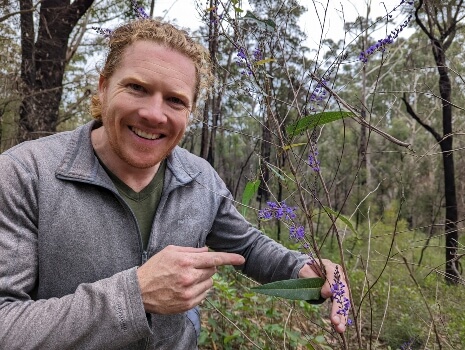
Nathan Schwartz of Aussie Green Thumb with a blooming Hardenbergia
Genus: | Hardenbergia |
|---|---|
Family: | Fabaceae |
Common Names: | false sarsaparilla, purple coral pea |
Height: | Up to 2 metres |
Width: | 2 - 3 metres |
Ideal position: | full sun or part shade |
Soil conditions: | Sandy, Loam, Well drained , Moist, Acidic , Neutral |
Flowers: | Lavender-blue, violet, pale pink and white flowers from late winter to early spring |
Maintenance level: | Low |
Poisonous to pets: | No |
Hardenbergia Plant Details
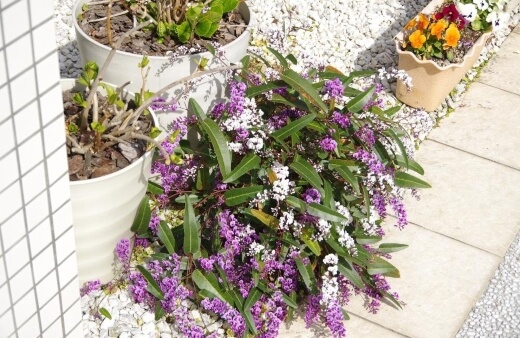
Hardenbergia is a genus of three species of plants in the pea family, Fabaceae and is endemic to Australia. The evergreen vine Hardenbergia species has dark green, smooth, spear-shaped leaves which grow between 2.5 to 13 centimetres long. The vines climb using tendrils that attach to a support structure.
The Hardenbergia produces a pea-shaped flower and the blooms are four petals. The common cultivars found in nurseries include the happy wanderer in purple, the pink fizz, and the purple falls.
The name of the genus is from English botanist George Bentham, who titled the three species in honour of Franziska Countess von Hardenberg in 1837.
In the wild, Hardenbergia grows through tree branches and across canyons and the plant is hardy to -3 degrees Celsius. This nitrogen-fixing plant is known by Australia’s aborigines as Waraburra.
When growing the plant from seed, pre-treatment is necessary. Hardenbergia seed requires acid scarification and pre-soaking in water at least 24 hours before sowing due to its hard seed coat.
Hardenbergia also needs to germinate in warm temperatures of at least 21 degrees Celsius.
Hardenbergia Varieties to Grow in Australia
The names of the three species of Hardenbergia are:
- Hardenbergia comptoniana
- Hardenbergia perbrevidens
- Hardenbergia violacea
Probably the most widely grown in Australia is the Hardenbergia violacea. Click here to read our full growing guide for Hardenbergia violacea in Australia.
Hardenbergia Varieties to Grow in Australia
The names of the three species of Hardenbergia are:
- Hardenbergia comptoniana
- Hardenbergia perbrevidens
- Hardenbergia violacea
More About Hardenbergia
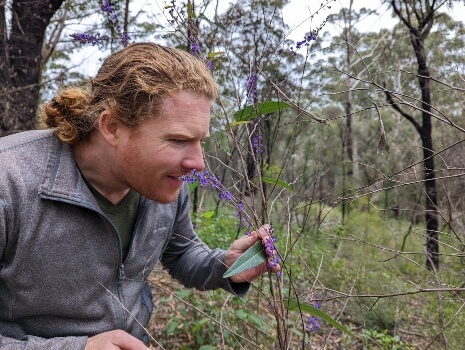
Nathan Schwartz of Aussie Green Thumb smelling a Hardenbergia flower
Hardenbergia is a hardy, evergreen, vigorous climbing plant. From winter through to spring, this plant produces an abundance of dark purple, pale pink or white pea flowers depending on the variety.


Get Your Free Guide:
Master Growing Australian Natives eBook
A Must Have Complete Guide for Every Australian Garden
Get Your Free Guide:
Master Growing Australian Natives eBook
A Must Have Complete Guide for Every Australian Garden
The plant needs a sunny or semi shaded position in the garden with free draining soil that contains manure or compost. This plant can also handle light frosts but ideally needs temperatures above 6 degrees Celsius.
Hardenbergia are fast growing and low maintenance. They can trail over fences if you’re looking for floral coverage and privacy or even trail along a trellis. Plant Hardenbergia as a beautiful feature plant or plant as a mass for a huge blooming impact.
You’ll need to water moderately all year round except in summer and prune the plant to 2/3 its size in late winter. The good news is this plant are quite resistant plants to pests and diseases and they propagate in late summer by cuttings and by seeds sown in spring.
Growing Hardenbergia in Australia
Growing this plant can be overwhelming if you don’t keep it in check. They can reach 15 metres in length, and the plant will twine itself around and climb everything in its path.
This means you’ll need to choose your planting site carefully and make sure the plant has a large, strong structure to climb or plenty of ground to spread.

Watering Schedule
Water throughout the active growth period, when the soil is dry to the touch and during periods of drought. You can apply a balanced liquid fertiliser monthly for better flowering and foliage. Keep the plant just moist in winter.
Sunlight Needs
Hardenbergia will be happiest in an area with full sun or part shade. They will thrive in full sun in areas with temperate summers. If your summers are very hot, plant in a place that gets some afternoon shade.
Best Soil to Use
This plant are best planted in well-drained soil of loam and sand with a neutral or acidic pH balance. If planting outside, you can tweak the native soil with organic matter to improve drainage.
If you are planting Hardenbergia in pots, you’ll need a loam-based potting compost with plenty of sharp sand and leaf mould. After planting, you want to water thoroughly and deeply to help the soil settle.
Pruning Hardenbergia
You can do some pruning at any time of year to keep your Hardenbergia in check. If you’re doing severe pruning, to half or even a third of its size, do this in spring after flowering is finished.
Hardenbergia Propagation
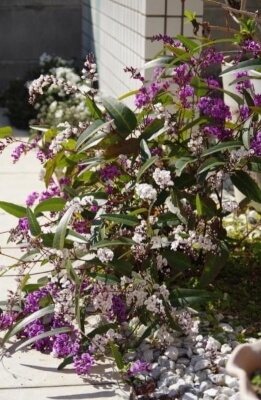
The easiest way to propagating Hardenbergia is by taking softwood cuttings during spring. To propagate successfully, you should take a cutting from the flexible young shoot tips.
Pinch out the soft tip and dip it in a hormone rooting powder or liquid. Make sure you have a container with cutting compost ready.
Make a hole for your cutting and insert into your container. Water thoroughly. Place the container with your cutting somewhere with a steady temperature ranging from 18-24°C.
These cuttings should be kept in a humid environment, so you can cover them in a plastic bag, making sure to remove the bag twice a week for about 15 minutes. It is vital that your cuttings are kept in partial sunlight with soil that is moist, for 6-10 weeks.
Once you are happy that your cuttings have rooted successfully, you can pot them individually. Increase their ventilation and remove dead or rotting foliage on a regular basis.
Hardenbergia Bush Tucker Guide
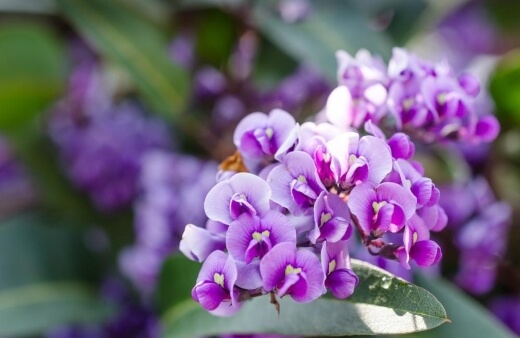
Although the flowers of this plant are not edible, you can add them to tea as a sweetener. You can also brew tea from the leaves, then cool and sweeten with native honey.
The tea is similar to green tea in flavour. You can crush and boil the leaves to achieve the desired flavour.
Our Australian bush tucker articles are about embracing bush tucker in your everyday life. We focus specifically on the flora aspect of native Australian food and medicine.
Hardenbergia Pests and Diseases to Look Out For
Hardenbergia are susceptible to powdery mildew in cool moist weather. If this happens, the plant should be monitored and treated with an appropriate organic fungicide if needed.
Neem oil is great for this. Neem oil works by preventing the germination and penetration of fungal spores into leaf tissue. Neem oil won't cure a plant that is already infected with a fungal disease, but it can help limit the spread of the disease to healthy tissue.
Fungal problems can be minimised if you avoid wetting the leaves when you do your watering and by removing dead leaves to improve air circulation.
See our compilation of common lawn problems and their solutions to help you maintain your garden.
Monitoring your plants for signs of leaf damage helps to avoid major pest infestations, like caterpillars. Scale insects and mealybugs can also become a problem if the plant is too crowded.
Scale can be a pest for this plant. You can squash or scrape off scale on the stems or the underside of leaves and you’ll need to heavily prune infested growth. If you’re dealing with serious infestations, you can spray with neem oil.
Have you signed up for our newsletter yet? When you join, you get two free gardening ebooks as our way of saying thanks.
Our newsletters are packed with plenty of gardening inspiration including product reviews, gardening events all over Australia, featured plants, and links to great resources.
Hardenbergia Frequently Asked Questions
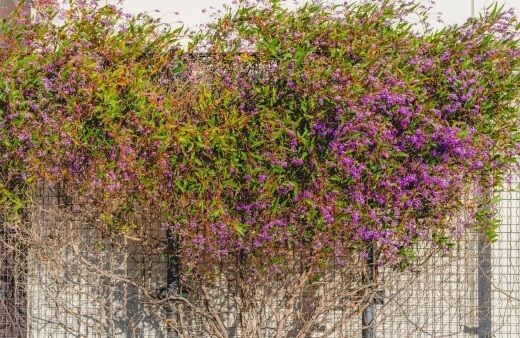
What were the historical uses of the Hardenbergia plant?
Indigenous Australians used the flowers of the Hardenbergia as a seasonal calendar of sorts. It helped them decide when they could fish from the creeks sustainably. They also used the plant for:
- Treating mouth ulcers, chest complaints, and stomach cramps
- Eating flowers to detox and cleanse
- Weaving the vine to create ropes, fishnets and traps
- Making a dye from the flowers
What is the nutritional value of the Hardenbergia seeds?
Hardenbergia seeds are high in Potassium, Calcium, Manganese, Magnesium, Zinc, Copper, Nitrogen and Sodium.
Why is Hardenbergia sometimes called a soil medicine?
The plant actually fixes nitrogen in soils for use by other plants.
What kind of dye do you get from Hardenbergia flowers?
A grey-blue dye is obtained from the flowers.
Looking for more purple plants to grow in your garden? If you are, then be sure to check out our comprehensive guide to growing Hovea acutifolia, also known as the purple pea bush.

Wrapping Up Our Hardenbergia Growing and Care Guide
Hardenbergia makes the perfect ground cover with its impressive spread, but is just as equally at home climbing a trellis or decorating a back wall with gorgeous blooms.
Propagating these beauties is easy from seed or cuttings, and you might be so charmed by this plant that you end up filling many pots and parts of your garden with them.
The flowers range in colour with pinks and purples and white, and are often the subject of a photo or two, trying to capture their beauty. Make yourself a cup of tea (with the flowers and leaves of your Hardenbergia of course) and enjoy the birds and butterflies that are attracted to this lovely Australian native.
We’re giving Hardenbergia our green thumbs up!
Published on July 4, 2022 by Nathan Schwartz
Last Updated on April 3, 2024





Hi Nathan
Thanks for the info on these beautiful plants. I've just bought two violacea's (one white & one purple) and have tasked them with blocking the view of my neighbour's ugly roof! Will a 50mm pot keep them happy?
Hi Lin,
In an ideal world they should reach about 2m tall, so you’ll need to plant them in a container or pot for sure, even if it’s just to get that extra height to provide screening.
They do spread too, which should be encouraged for a bushier plant, and like any shrub cutting while they grow will encourage a more dense effect later on, so cut them back by 1/3 each year to encourage more effective screening.
Now, for the important part… the pot! 50cm (definitely cm not mm) is about right for these shrubs, but the bigger the pot the better. Mature plants can have root balls reaching out beyond 2m, so if you’ve got any long-wider planter, rather than round pots, you can encourage more natural rooting.
If space is an issue, go for a 50cm pot and feed them once or twice a year once they establish. If you’ve got the space though, build a raised bed, or add a 1.5m long, by 50cm deep planter in front of the fence, and plant your Hardenbergia violacea with even spacing into it.
Happy Gardening!
Nathan Schwartz
Hello!
I'd like to create a low maintenance, native garden at my Sydney (inner west) home. Wire runners are already installed along my boundary fences, ready for a native climber. I'll need a few plants, as I'd like them to cover 2 long boundary fences. A horticulturist recommended the Hardenbergia Comptoniana climber.
Can you please tell me where I can buy Hardenbergia Comptoniana. Do you sell them? I've called a few nurseries but they don't stock. Assuming I can buy them, do you think it is a suitable, low maintenance native climber or would you recommend something else?
If I cannot buy Hardenbergia Comptoniana, what do you recommend as a substitute? Do you recommend Hardenbergia Violacea Happy Wanderer or Free and Easy? I like colour in my garden, so the purple wisteria appeals.
Appreciate your advice and hope you can help.
Many thanks
Hi Rosanna,
I don’t think you can do much better than Hardenbergia comptoniana for a low maintenance climber, especially if bold colour is the aim. It’s one of the most vigorous climbers you can grow, and would easily take over the fence. The only maintenance you’ll need to do is cut it back when it gets too big, maybe once every three years or so.
We don’t sell plants, but you can get young mail order plants from Wildtech plants: https://www.wildtechnursery.com.au/product/hardenbergia-comptoniana/.
They’re only young plants, but if you dig in some good compost and prepare the ground well, they should take quickly and cover the fence in a 4-5 years (they also stock Hardenbergia violacea).
At the right time of year, I think they’ll probably have them in any big garden centre or DIY store with a garden section.
The only other thing I’d suggest, in case you want to try out climbers first, is to test out annuals, or fast growing but short-lived perennials like Bougainvillea, or even sweet peas. They’re higher maintenance and need feeding, but it’ll give you a better idea of the sort of colour you’re after.
A few packets of different coloured sweet pea seeds, sown directly into the ground with plenty of compost, a weekly water, and a monthly feed will give you an incredible display this year, and you’ll know exactly the colour scheme you want the year after.
Best regards,
Nathan Schwartz
Aussie Green Thumb